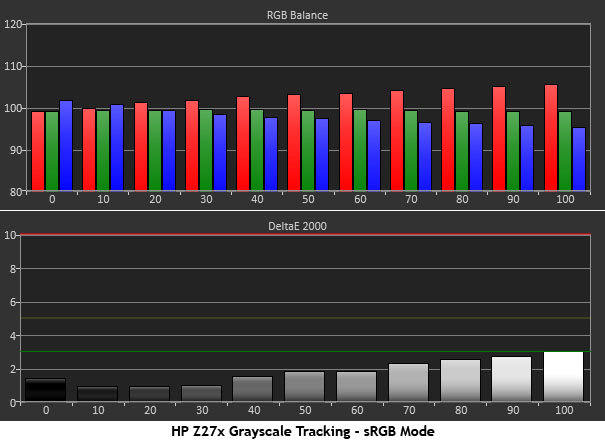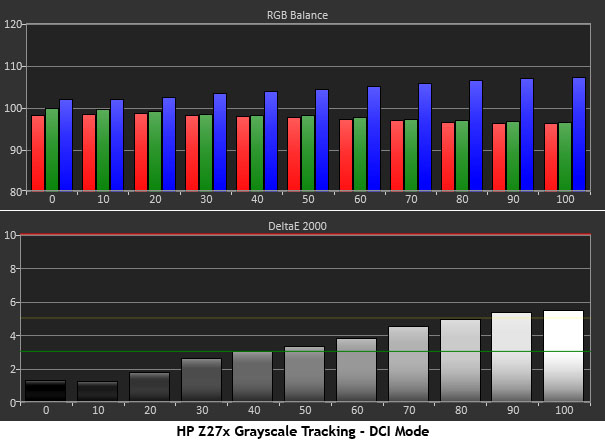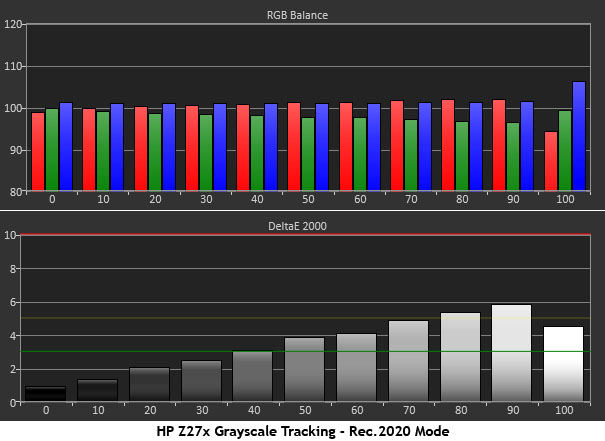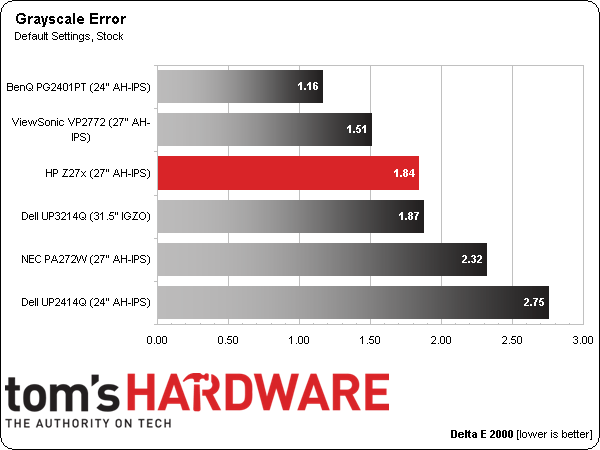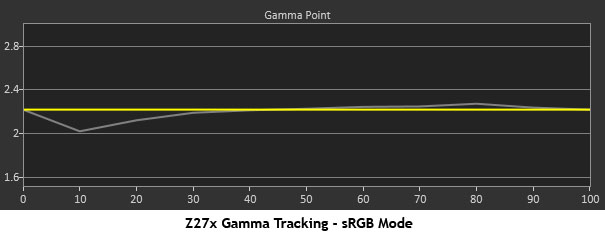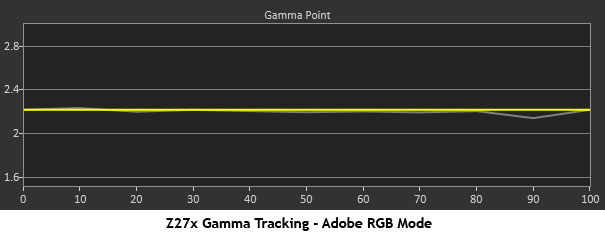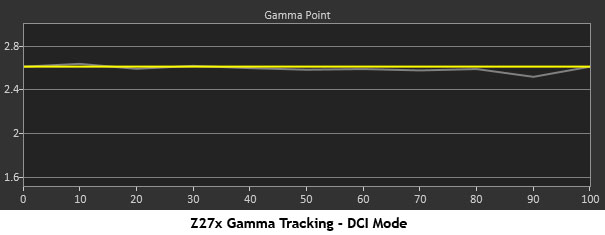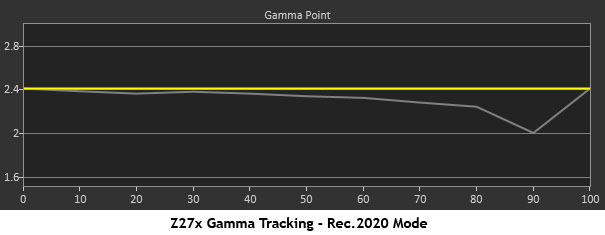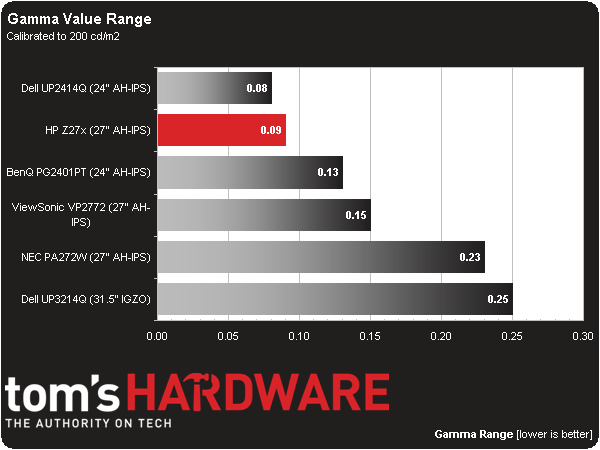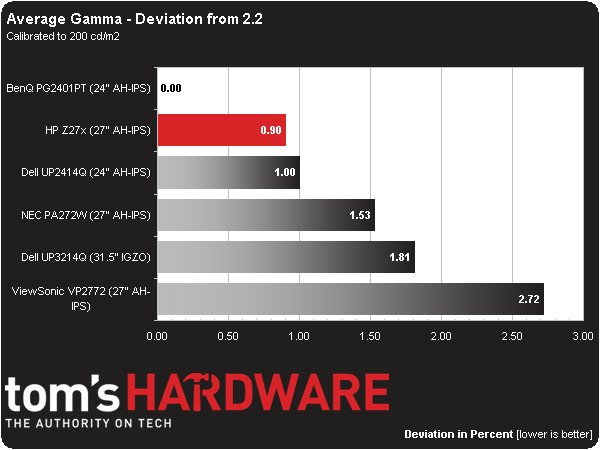HP Z27x Dreamcolor Professional Display Review
HP's new Z27x DreamColor supports all the important color gamuts and carries some distinctly unique features. This screen simply blows us away.
Why you can trust Tom's Hardware
Results: Grayscale Tracking And Gamma Response
Our grayscale and gamma tests are described in detail here.
We’re going to show the grayscale, gamma, and color results for the four most-used color modes: sRGB, Adobe RGB, DCI, and Rec.2020. They are the color standards professionals would likely employ in their work.
Our before and after results were similar, so we’re showing just the post-calibration charts. We used an i1Display-based instrument, which is not the best tool for measuring color in our experience. We believe if the Z27x were adjusted with an i1Pro or high-end spectroradiometer, the results would be even better.
For sRGB mode, we used the standard white point of D65 or 6500 Kelvins. The measurements run a tiny bit warm, though the error is invisible at all brightness levels. The average Delta E value is 1.85.
Switching to Adobe RGB, also at D65, results in a little extra blue as brightness levels rise. At 90 percent you can just see a tiny error. The average error is 2.21 Delta E.
The DCI white point is typically set at D54. It injects a little extra green to compensate for the different spectral properties of a commercial projector’s xenon bulb. The Z27x runs too cool, and shows errors at 50-percent brightness and above. The average error is 5.63 Delta E. If you plan to work in the DCI colorspace, we recommend using an i1Pro or better to calibrate.
Since the Z27x only shows a subset of the Rec.2020 gamut, grayscale suffers from a slight lack of green. To our eyes, it looked too blue. Again, the error is visible from 50 percent on up, and has an average value of 3.52 Delta E.
Get Tom's Hardware's best news and in-depth reviews, straight to your inbox.
Here is our comparison group:
We’re comparing the Z27x’s best mode, which is sRGB. Running the internal calibration routine with a DreamColor i1Display produced almost no change in the grayscale result.
A .01 rise in average Delta E is essentially nothing in this test. To extract the Z27x’s maximum potential, a spectrophotometer or spectroradiometer should be used to calibrate, rather than the tri-stimulus instrument we employed. While these are decent results, we believe they could be better.
Gamma Response
The Z27x doesn’t support gamma BT.1886 in its current firmware. By the time you read this, we're told that omission will have been rectified. All the gamma presets are based on the power function. For sRGB and Adobe RGB, that means a value of 2.2.
The resulting trace is pretty good except for a slight dip (too bright) at the 10-percent level. The luminance error is .9356 cd/m2, which is barely visible. Otherwise, tracking is nice and tight at the 2.2 mark.
The Adobe RGB trace is within a whisker of perfection. The target is the same as for sRGB (2.2). The dip at 90 percent represents a less-than 1.8 cd/m2 error, well below the threshold of visibility.
DCI specifies a gamma of 2.6 and the Z27x matches it almost exactly. The dip at 90 percent is just 2 cd/m2 of extra brightness.
Rec.2020 is still a proposed standard and for now, it calls for a gamma value of 2.4 using the power function. The HP screen shows the same dip at 90 percent as the other color modes. But this time, it’s greater at over 9 cd/m2. Since BT.1886 is being phased in with Rec.709 content, it seems likely that standard will make its way to Rec.2020 UHD displays eventually.
Here is our comparison group again. The Z27x’s results represent the sRGB color mode.
A result of .09 is extremely tight tracking. Other than the slight error at 90 percent, gamma is perfect in the sRGB, Adobe RGB, and DCI modes.
We calculate gamma deviation by simply expressing the difference from 2.2 as a percentage.
If it weren’t for the dip at 90 percent, the deviation would likely be zero. We believe the Z27x can achieve this if calibrated with the right instruments.
Current page: Results: Grayscale Tracking And Gamma Response
Prev Page Results: Brightness And Contrast Next Page Results: Color Gamut Accuracy
Christian Eberle is a Contributing Editor for Tom's Hardware US. He's a veteran reviewer of A/V equipment, specializing in monitors. Christian began his obsession with tech when he built his first PC in 1991, a 286 running DOS 3.0 at a blazing 12MHz. In 2006, he undertook training from the Imaging Science Foundation in video calibration and testing and thus started a passion for precise imaging that persists to this day. He is also a professional musician with a degree from the New England Conservatory as a classical bassoonist which he used to good effect as a performer with the West Point Army Band from 1987 to 2013. He enjoys watching movies and listening to high-end audio in his custom-built home theater and can be seen riding trails near his home on a race-ready ICE VTX recumbent trike. Christian enjoys the endless summer in Florida where he lives with his wife and Chihuahua and plays with orchestras around the state.
-
DoDidDont I have 3x Z24x, very impressed with them so far for compositing and 3d work. Would have gone with 3x Z27x but simply don’t have the desk space or room for a bigger desk. My only worry is if they have the same problem as the older ZR24w’s they replaced, in that the whites go yellowish and make greys have a tint of brown after only one or two years of use. Always had a dark grey desktop, and in 3ds max everything is set to Dark GUI, and always been careful not to leave monitors on for long periods with the same image so no idea why the older ZR24w’s go yellowish after a while. Hopefully this problem has been fixed in the new line-up. But at the Mo, highly recommend these monitors, amazing quality for the price if you are into DCC.Reply -
laststop311 .29 is not a good black level really. Hopefully oleds will displace the need for these monitors soon, only a matter of timeReply -
somebodyspecial hopefully 1600p will displace 1440p soon ;) I'm tired of scrolling up/down so much on web pages. Gaming doesn't get any better wide either, and if I want that I'll use more than one monitor to get the best of both worlds (taller for the web, and wider for games if desired).Reply -
laststop311 Reply14215918 said:hopefully 1600p will displace 1440p soon ;) I'm tired of scrolling up/down so much on web pages. Gaming doesn't get any better wide either, and if I want that I'll use more than one monitor to get the best of both worlds (taller for the web, and wider for games if desired).
Agree 100% I had a 24" 1920x1080 Cheapo TN monitor and then I found a Dell u3014 on craigslist and jewed the guy down to 575 for it. The bezel was a little scuffed up but the screen was flawless was a hell of a deal and man once you are used to 16:10 you cant go back to 16:9 it feels claustrophobic.
I am not a graphics professional though. But I fear since 16:10 is more a professional monitor we will never see a gaming monitor with 120hz and g sync in 16:10. I just can't bring myself to downgrade to a 27" asus rog swift even tho i really could use the gaming features. I'm probably just going to hold onto this dell until 120hz 3840x2160 rog swift type monitor is released at 30-34 inches. I don't think there is much hope in 16:10 4k monitors, never seen one yet 3840 x 2400 i believe.
-
Draven35 When I was at HP in Fort Collins for the new Z Workstation launch, I had an opportunity (several opportunities, really) to chat with Greg Staten, the HP DreamColor Solution Architect. He's really enthusiastic about his work and was really excited that this review was coming!Reply -
rajubaju Complaints about lack of CMS in OSD... I couldn't agree with them more. Totally unacceptable... Especially when you know; z24x provides that possibility (like every other, wide gamut, monitor on the market; nec pa272w, dell u2713h, asus pa279q, vp2772, lg 27ea83-D etc.) In the z24x manual, we can read: "the User (User Preset) adjustable color settings for customers who do not have calibration equipment". What is the difference? with z27x - price i guess - you pay more, you get less! ;) I understand that now, when I buy z27x, I must buy a colorimeter (HP ofc)... even if I do not need ideal color accuracy... and i only want adjust monitor (RGB primaries) for my preferences. Not a chance! I hope that Greg Staten read this and add User preset, like in z24x, to Z27x... About saturation, 6 color adjustment, etc. I don't even dream; It would be a miracle! ;)Reply
